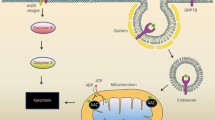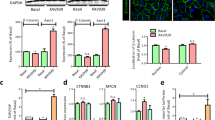Abstract
Farnesyltransferase inhibitors (FTIs) are novel anticancer drugs that inhibit the secretion of pro-angiogenic factors by Ras-transformed cancer cells. FTIs also inhibit angiogenesis in a rat corneal model, suggesting that FTIs have anti-angiogenic properties that extend beyond targeting cancer cells. Our hypothesis was that FTIs may directly target endothelial cell functions in angiogenesis. We examined the effects of FTI treatment on a range of assays designed to pick apart the individual functions of endothelial cells during angiogenesis. We found that FTIs inhibit endothelial cell proliferation, causing a failure of mitosis and accumulation of binucleate cells. FTIs also block the directional migration of endothelial cells toward VEGF, the major pro-angiogenic factor in adult tissues. In a co-culture assay of angiogenesis, FTI treatment significantly inhibits tube formation, but has no effect on pre-existing structures. Defects in tube formation could be replicated by specific targeting of endothelial cell farnesyltransferase using RNA interference. Our data show that FTIs directly target endothelial cells in angiogenesis, explaining previous in vivo findings. Importantly, these results suggest that the therapeutic use of FTIs may extend beyond cancer to include the treatment of other diseases involving pathological angiogenesis.







Similar content being viewed by others
References
Carmeliet P (2000) Mechanisms of angiogenesis and arteriogenesis. Nat Med 6:389–395
Pugh CW, Ratcliffe PJ (2003) Regulation of angiogenesis by hypoxia: role of the HIF system. Nat Med 9:677–684
Carmeliet P (2003) Angiogenesis in health and disease. Nat Med 9:653–660
Carmeliet P (2004) Manipulating angiogenesis in medicine. J Intern Med 255:538–561
Frank RN (2004) Diabetic retinopathy. N Engl J Med 350:48–58
Liao D, Johnson RS (2007) Hypoxia: a key regulator of angiogenesis in cancer. Cancer Metastasis Rev 26:281–290
Rak J, Mitsuhashi Y, Bayko L, Filmus J, Shirasawa S, Sasazuki T, Kerbel RS (1995) Mutant ras oncogenes upregulate VEGF/VPF expression: implications for induction and inhibition of tumor angiogenesis. Cancer Res 55:4575–4580
Arbiser JL, Moses MA, Fernandez CA, Ghiso N, Cao Y, Klauber N, Frank D, Brownlee M, Flynn E, Parangi S, Byers HR, Folkman J (1997) Oncogenic H-ras stimulates tumor angiogenesis by two distinct pathways. Proc Natl Acad Sci U S A 94:861–866
Kranenburg O, Gebbink MF, Voest EE (2004) Stimulation of angiogenesis by Ras proteins. Biochim Biophys Acta 1654:23–37
Gu WZ, Tahir SK, Wang YC, Zhang HC, Cherian SP, O’Connor S, Leal JA, Rosenberg SH, Ng SC (1999) Effect of novel CAAX peptidomimetic farnesyltransferase inhibitor on angiogenesis in vitro and in vivo. Eur J Cancer 35:1394–1401
Ferguson D, Rodriguez LE, Palma JP, Refici M, Jarvis K, O’Connor J, Sullivan GM, Frost D, Marsh K, Bauch J, Zhang H, Lin NH, Rosenberg S, Sham HL, Joseph IB (2005) Antitumor activity of orally bioavailable farnesyltransferase inhibitor, ABT-100, is mediated by antiproliferative, proapoptotic, and antiangiogenic effects in xenograft models. Clin Cancer Res 11:3045–3054
Han JY, Oh SH, Morgillo F, Myers JN, Kim E, Hong WK, Lee HY (2005) Hypoxia-inducible factor 1alpha and antiangiogenic activity of farnesyltransferase inhibitor SCH66336 in human aerodigestive tract cancer. J Natl Cancer Inst 97:1272–1286
Oh SH, Kim WY, Kim JH, Younes MN, El-Naggar AK, Myers JN, Kies M, Cohen P, Khuri F, Hong WK, Lee HY (2006) Identification of insulin-like growth factor binding protein-3 as a farnesyl transferase inhibitor SCH66336-induced negative regulator of angiogenesis in head and neck squamous cell carcinoma. Clin Cancer Res 12:653–661
Feldkamp MM, Lau N, Guha A (1999) Growth inhibition of astrocytoma cells by farnesyl transferase inhibitors is mediated by a combination of anti-proliferative, pro-apoptotic and anti-angiogenic effects. Oncogene 18:7514–7526
Zhang B, Prendergast GC, Fenton RG (2002) Farnesyltransferase inhibitors reverse Ras-mediated inhibition of Fas gene expression. Cancer Res 62:450–458
Prendergast GC (2000) Farnesyltransferase inhibitors: antineoplastic mechanism and clinical prospects. Curr Opin Cell Biol 12:166–173
Van Hinsbergh WM, Draijer R (1996) Culture and characterization of human endothelial cells. Oxford University Press, Oxford
Gampel A, Moss L, Jones MC, Brunton V, Norman JC, Mellor H (2006) VEGF regulates the mobilization of VEGFR2/KDR from an intracellular endothelial storage compartment. Blood 108:2624–2631
Bishop ET, Bell GT, Bloor S, Broom IJ, Hendry NF, Wheatley DN (1999) An in vitro model of angiogenesis: basic features. Angiogenesis 3:335–344
Donovan D, Brown NJ, Bishop ET, Lewis CE (2001) Comparison of three in vitro human ‘angiogenesis’ assays with capillaries formed in vivo. Angiogenesis 4:113–121
Gampel A, Mellor H (2002) Small interfering RNAs as a tool to assign Rho GTPase exchange-factor function in vivo. Biochem J 366:393–398
Reynolds AR, Reynolds LE, Nagel TE, Lively JC, Robinson SD, Hicklin DJ, Bodary SC, Hodivala-Dilke KM (2004) Elevated Flk1 (vascular endothelial growth factor receptor 2) signaling mediates enhanced angiogenesis in beta3-integrin-deficient mice. Cancer Res 64:8643–8650
Sebti SM, Hamilton AD (2000) Farnesyltransferase and geranylgeranyltransferase I inhibitors and cancer therapy: lessons from mechanism and bench-to-bedside translational studies. Oncogene 19:6584–6593
Davis GE, Senger DR (2005) Endothelial extracellular matrix: biosynthesis, remodeling, and functions during vascular morphogenesis and neovessel stabilization. Circ Res 97:1093–1107
Waltenberger J, Claesson-Welsh L, Siegbahn A, Shibuya M, Heldin CH (1994) Different signal transduction properties of KDR and Flt1, two receptors for vascular endothelial growth factor. J Biol Chem 269:26988–26995
Mavria G, Vercoulen Y, Yeo M, Paterson H, Karasarides M, Marais R, Bird D, Marshall CJ (2006) ERK-MAPK signaling opposes Rho-kinase to promote endothelial cell survival and sprouting during angiogenesis. Cancer Cell 9:33–44
Go RS, Owen WG (2003) The rat aortic ring assay for in vitro study of angiogenesis. Methods Mol Med 85:59–64
Sebti SM (2005) Protein farnesylation: implications for normal physiology, malignant transformation, and cancer therapy. Cancer Cell 7:297–300
Schaar BT, Chan GK, Maddox P, Salmon ED, Yen TJ (1997) CENP-E function at kinetochores is essential for chromosome alignment. J Cell Biol 139:1373–1382
Hussein D, Taylor SS (2002) Farnesylation of Cenp-F is required for G2/M progression and degradation after mitosis. J Cell Sci 115:3403–3414
Bomont P, Maddox P, Shah JV, Desai AB, Cleveland DW (2005) Unstable microtubule capture at kinetochores depleted of the centromere-associated protein CENP-F. EMBO J 24:3927–3939
Schafer-Hales K, Iaconelli J, Snyder JP, Prussia A, Nettles JH, El-Naggar A, Khuri FR, Giannakakou P, Marcus AI (2007) Farnesyl transferase inhibitors impair chromosomal maintenance in cell lines and human tumors by compromising CENP-E and CENP-F function. Mol Cancer Ther 6:1317–1328
Gupton SL, Gertler FB (2007) Filopodia: the fingers that do the walking. Sci STKE 2007: re5
Gerhardt H, Golding M, Fruttiger M, Ruhrberg C, Lundkvist A, Abramsson A, Jeltsch M, Mitchell C, Alitalo K, Shima D, Betsholtz C (2003) VEGF guides angiogenic sprouting utilizing endothelial tip cell filopodia. J Cell Biol 161:1163–1177
Ruhrberg C, Gerhardt H, Golding M, Watson R, Ioannidou S, Fujisawa H, Betsholtz C, Shima DT (2002) Spatially restricted patterning cues provided by heparin-binding VEGF-A control blood vessel branching morphogenesis. Genes Dev 16:2684–2698
Gerhardt H, Ruhrberg C, Abramsson A, Fujisawa H, Shima D, Betsholtz C (2004) Neuropilin-1 is required for endothelial tip cell guidance in the developing central nervous system. Dev Dyn 231:503–509
Lu X, Le Noble F, Yuan L, Jiang Q, De Lafarge B, Sugiyama D, Breant C, Claes F, De Smet F, Thomas JL, Autiero M, Carmeliet P, Tessier-Lavigne M, Eichmann A (2004) The netrin receptor UNC5B mediates guidance events controlling morphogenesis of the vascular system. Nature 432:179–186
Mijimolle N, Velasco J, Dubus P, Guerra C, Weinbaum CA, Casey PJ, Campuzano V, Barbacid M (2005) Protein farnesyltransferase in embryogenesis, adult homeostasis, and tumor development. Cancer Cell 7:313–324
Reynolds LP, Killilea SD, Redmer DA (1992) Angiogenesis in the female reproductive system. FASEB J 6:886–892
Karp JE, Lancet JE (2007) Development of farnesyltransferase inhibitors for clinical cancer therapy: focus on hematologic malignancies. Cancer Invest 25:484–494
Tonnesen MG, Feng X, Clark RA (2000) Angiogenesis in wound healing. J Investig Dermatol Symp Proc 5:40–46
Dorrell M, Uusitalo-Jarvinen H, Aguilar E, Friedlander M (2007) Ocular neovascularization: basic mechanisms and therapeutic advances. Surv Ophthalmol 52(Suppl 1):S3–S19
Acknowledgments
This study was supported by a British Heart Foundation Project Grant to HM and a Medical Research Council Infrastructure Award to the School of Medical Sciences Imaging Centre.
Author information
Authors and Affiliations
Corresponding author
Electronic supplementary material
Below is the link to the electronic supplementary material.
10456_2008_9115_MOESM1_ESM.pdf
MOESM1 [FTI inhibits proliferation in a co-culture assay of angiogenesis. Assays were performed in the absence or presence of FTI for the periods indicated. Prior to fixation, cells were treated with BrdU for 2 h to label actively proliferating cells. Cells were then fixed and stained with DAPI (blue) to reveal endothelial cells and fibroblasts, and with PECAM-1 (green) to reveal the endothelial cells. Staining for BrdU incorporation is shown in the right-hand panels. In each case, areas containing both endothelial cells and fibroblasts were selected. In the right-hand panels, In the right-hand panels, the line marks the boundary between the two cell types. Active proliferation of endothelial cells was restricted to the first 4 days, whereas fibroblast proliferation continued throughout the assay. FTI treatment blocked the proliferation of endothelial cells. Scale bar represents 20 μm (PDF 345 kb)
Rights and permissions
About this article
Cite this article
Scott, A.N., Hetheridge, C., Reynolds, A.R. et al. Farnesyltransferase inhibitors target multiple endothelial cell functions in angiogenesis. Angiogenesis 11, 337–346 (2008). https://doi.org/10.1007/s10456-008-9115-3
Received:
Accepted:
Published:
Issue Date:
DOI: https://doi.org/10.1007/s10456-008-9115-3




